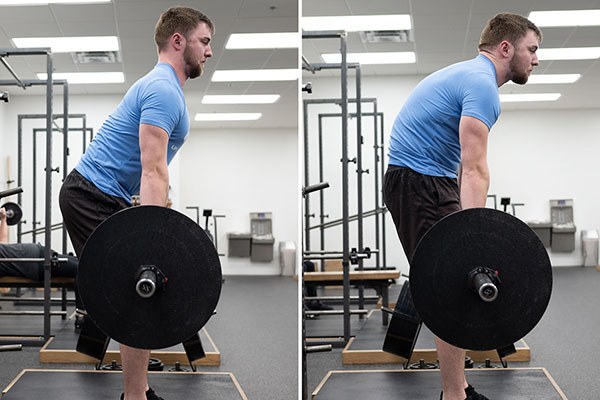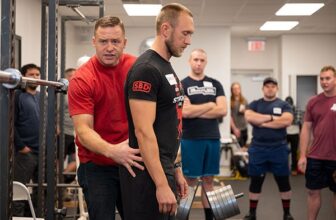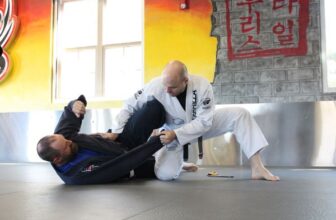
[adinserter block=”2″]
This is a rather fundamental issue for many inexperienced trainees, especially those people who are not gifted athletes with the natural ability to use their bodies optimally. Let’s discuss the differences between the two, the reasons why they are important, and how to best clarify the procedures for using the back safely and efficiently under a heavy load.

Back Angle refers to the generalized plane of the torso and the angle it makes with the floor when you are standing on a horizontal surface. If you are standing upright, your back angle is about 90 degrees. If your back is parallel to the floor, your back angle is 0 degrees. The back angle during squats and deadlifts will be somewhere between these two extremes, and will naturally vary with anthropometry – the lengths of your torso, thigh, and shank segments – and with your ability to control your position throughout the execution of the movements.
Spinal Position refers to the relationships between the spinal vertebral segments, and how they differ from “Normal Anatomical Position.” The human spine is not arranged in a straight line, as may be popularly understood. The three regions of the spine – lumbar at the bottom, thoracic in the middle, and cervical in the neck – are curved when standing in “Normal Anatomical Position,” (or NAP) the standing upright position used as the reference for human anatomy. The lumbar spine curves towards the front (anterior) of the body, the thoracic spine curves back (posterior), and the cervical spine has a slight anterior curve. The forward curves are referred to as “lordotic” (a lordosis), and the backward curve of the thoracic is referred to as “kyphotic” (a kyphosis).
These three curves are anatomical, in that the vertebral bodies and the intervertebral discs are shaped in a way that naturally produces these curves while standing upright in NAP. Since this position is normal to human anatomy, normal anatomical position is the best position for loading the musculoskeletal system. The healthy spine can tolerate some deviation from NAP, but attention should always be paid to maintaining this spinal position so that an intervertebral disc is not placed in non-anatomical compression under a heavy load.
Intra-spinal
vertebral relationships can change as a part of normal human
movement. A sit-up is a voluntary spinal flexion, while a glute/ham
raise is a voluntary spinal extension – and please note that
neither one of these exercises is performed under a compressive load.
If the spine is loaded in compression, the position must be NAP. You
can place your lumbar spine in flexion,
allowing your normal lumbar lordotic curve to become more kyphotic,
as when your low back rounds at the start of a deadlift. Or you can
extend
your lumbar spine, as when you set your low back at the start of a
deadlift.
Here
is where the difference between back angle and spinal position
becomes very important. It is unfortunately difficult for some people
to voluntarily assume a position of rigid spinal extension when the
back angle is more horizontal than an upright position. Pulling a
deadlift off the floor or squatting through most of the range of
motion inherently involves loading the spine in a non-vertical
position. This means that the correct start of a deadlift or any
pull, and the correct back position for a deadlift must be spinal
extension, which both gravity and tension from the hamstrings on the
pelvis will be opposing.
We
rely on the deadlift to strengthen this position, because it’s very
easy to focus on low-back extension as the bar comes off the floor.
The squat is equally dependent on low-back strength, but it’s a more
complex movement that starts at the top where there is not much
leverage against the spine, and uses back tightness during the drive
out of the bottom – lots of other stuff to think about. The
deadlift starts at the hardest position for keeping the back flat,
but it is a rather simple movement pattern to execute, and it allows
the lifter to develop the ability to focus intensively on the low
back position, since not much else is going on. The deadlift is in
the program because that is where low-back strength is built.
This
means that 1.) the correct spinal position must be correctly assumed,
and 2.) that you’re strong enough to hold it as the angle changes
from some degree of horizontal to vertical at lockout.
Assuming
the correct extended spinal position requires a familiarity
with “arching” the back sufficient to enable you to quickly set
the position between your big breath and pushing the bar away from
the floor. Some people have a great deal of difficulty identifying
and voluntarily assuming this low-back set position, and a good coach
is equipped with the cues to enable rapid improvement. Once the
position is identified, strength comes quickly, but you can’t
strengthen a position you cannot assume, so learning to set the low
back is perhaps the most important thing you need to learn in the
weight room.
Strengthening
the extended low back – just like strengthening anything else –
is a function of holding that position as the weight on the bar goes
up. No compromise can be tolerated. You have to lift heavy weights
with your back “flat” or the damn thing will never get strong.
And concentric/eccentric assistance exercises like back extensions or
“reverse hypers” will not strengthen the start of a deadlift or
the bottom of a squat, no matter who tells you they will.
Your
clean and your snatch also depend on this position, since they have
to perform an acceleration in extension even though the weight is
lighter. If you do not train heavy pulls with a flat back, your low
back will not be strong, your technique will be a “power leak” –
all the pulling force will not get to the bar, and the bar path will
vary as different amounts of force pull the load.
There
is no easy way out, no trick exercise or machine that can do this for
you. You have to set
the low back in extension, and hold it in extension as your deadlift
goes up. So you
have to learn the position and you have to strengthen the position
with heavy weights on the deadlift.
Discuss in Forums
[adinserter block=”2″]
Credit : Source Post






